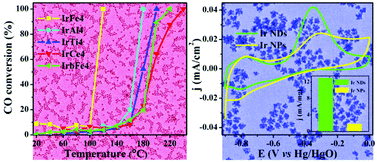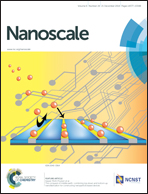Synthesis of dendritic iridium nanostructures based on the oriented attachment mechanism and their enhanced CO and ammonia catalytic activities†
Abstract
Branched iridium nanodendrites (Ir NDs) have been synthesized by a simple method based on the oriented attachment mechanism. Transmission electron microscopy images reveal the temporal growth process from small particles to NDs. Precursor concentrations and reaction temperatures have a limited effect on the morphology of Ir NDs. Metal oxide and hydroxide-supported Ir NDs exhibit enhanced activity for catalytic CO oxidation. Particularly, the Fe(OH)x-supported Ir NDs catalyst with a 4 wt% Ir loading show superior CO oxidation catalytic activity with a full conversion of CO at 120 °C. Furthermore, compared with Ir NPs and commercial Ir black, Ir NDs exhibit higher activity and stability for ammonia oxidation. The specific activity and mass activity of Ir NDs for ammonia oxidation are 1.7 and 7 times higher than that of Ir NPs. The improved catalytic activities of Ir NDs are attributed not only to their large specific surface area, but also to their considerably high index facets and rich edge and corner atoms. Hence, the obtained Ir NDs provide a promising alternative for direct ammonia fuel cells and proton-exchange membrane fuel cells.


 Please wait while we load your content...
Please wait while we load your content...